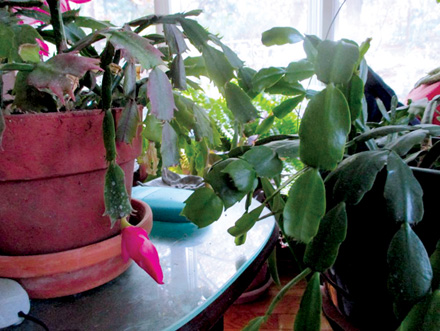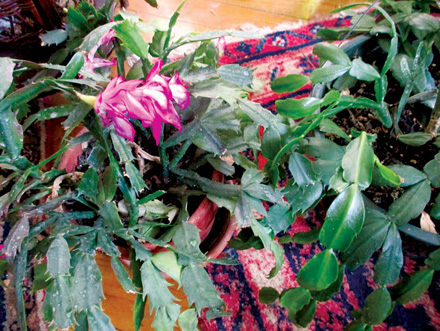Getting Christmas Cactus to Bloom

“The Christmas cactus from my grandmother is getting ready to bloom, what did I do wrong? – Martha
Hi Martha, I have a “Christmas” cactus blooming right now, I’m embracing the blooms and calling it my Thanksgiving cactus. The answer is a combination of the kind of Schlumbergera plant you have, when it is exposed to cooler temperatures and sometimes, how much daily light it gets.
These hardy but tropical plants need a little help to bloom on cue here in North America. Back in their native habitat in Brazil they have weather triggers to get them to bloom in December, the beginning of the South American summer. I grew up near their native habitat, Christmas without swimsuits still seems a little odd to me but now I’m happy just unwrapping them as a gift.
There are several different Schlumbergera varieties including an Easter one your cactus came from your grandmother. Your cactus may be the older, true Christmas cactus. Most cactuses sold on the market today are actually Thanksgiving cacti, which explains why they tend to bloom end of November. They are grown in greenhouse conditions to get them to set bud for sale around Thanksgiving.
To determine what kind of cactus you have, look at the green fronds. The original Christmas cactuses (Schlumbergera bridgesii) have smooth, round edges while Thanksgiving cacti (Schlumbergera truncata) have pointy, jagged ones.
Like other succulents, cacti are well-adapted to life with little precipitation. The leaves have evolved into spines, which in addition to allowing less water to evaporate than regular leaves, defend the cactus against water-seeking animals. Photosynthesis is carried out by enlarged stems, which store water. Unlike many other succulents, the stem is the only part of a true cactus where this takes place.
I have all three varieties although I haven’t determined a good way to distinguish between the Thanksgiving and Easter cacti. When they bloom, the Easter cactus has a different bloom than the other two.
My Thanksgiving cactus started to bloom because I had it outside on my back porch earlier this fall. The cooler temperatures triggered the buds to form without my doing any adjusting to the amount of light it was getting every day.
Holiday cacti are called “short day plants” meaning in order to produce flower buds, they require fewer daylight hours and/or cool night temperatures. The shorter days and cooler nights signal the plant to produce buds. I have tried both triggers and found the cooler temperatures are the easier way to encourage blooms.
To get your holiday cactus to bloom when you want the blooms, locate holiday cacti indoors in a cool, bright location where daytime temperatures are 65-70° F and evening temperatures are 55-65° F. If plants are exposed to cooler night temperatures of 55° F, plants will bloom in approximately 5-6 weeks, sometimes regardless of the day length.
I frankly don’t mind when they bloom out of season, I love having them in bloom any time they decide the time is right.
Charlotte Ekker Wiggins is a beekeeper, gardener and sometimes cook. Published by El Dorado Springs Sun once in print and online with author’s permission. Copyright 2017, all rights reserved. This column may not be reprinted, republished or otherwise distributed without author’s permission. Contact Charlotte at gardeningcharlotte at gmail dot com.

IF YOU SAY SO – On the left, Thanksgiving cactus, sold commercially as a Christmas cactus, with the little spikes at the end of the leaves. To the right, an old-fashioned Christmas cactus with the smooth leaf edges. These plants are no longer sold commercially.
 YOU’D BE CLOSE EITHER WAY – My Thanksgiving cactus is in bloom with the lovely pink flowers we often associate with Christmas cactus. (Photos by Charlotte Ekker Wiggins).
YOU’D BE CLOSE EITHER WAY – My Thanksgiving cactus is in bloom with the lovely pink flowers we often associate with Christmas cactus. (Photos by Charlotte Ekker Wiggins).



Facebook Comments